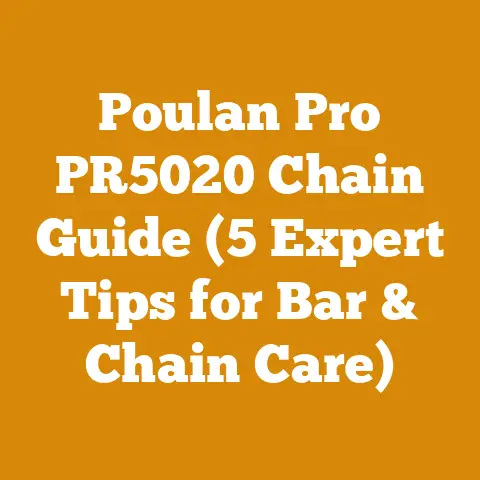Burning Pressure Treated Wood Risks (5 Toxic Compounds Revealed)
Imagine you’re nestled beside a crackling fire, the scent of woodsmoke filling the crisp evening air. It’s a picture of rustic comfort, isn’t it? But what if I told you that some of that wood could be releasing invisible toxins into the air, turning your cozy haven into a potential health hazard? That’s the chilling reality we face when considering burning pressure-treated wood. As someone who’s spent years felling trees, milling lumber, and preparing firewood, I’ve seen firsthand the consequences of misinformed practices. Let’s unravel the risks associated with burning pressure-treated wood and what toxic compounds are released. It’s a subject that deserves serious attention, and I’m here to guide you through it.
Burning Pressure Treated Wood: Revealing the 5 Toxic Compounds and Risks
Pressure-treated wood is designed for outdoor use, resisting rot, decay, and insect infestation. But this durability comes at a cost: chemical preservatives. When burned, these chemicals don’t just disappear; they transform into hazardous compounds that can pose significant risks to your health and the environment. Let’s break down those risks into the 5 toxic compounds revealed during combustion.
Understanding Pressure Treatment: A Brief Overview
Pressure-treated wood is lumber that has been infused with chemical preservatives under high pressure. This process forces the chemicals deep into the wood fibers, making it resistant to decay, insects, and fungal attacks. This makes it ideal for outdoor projects like decks, fences, and landscaping structures.
Common Preservatives Used:
- Chromated Copper Arsenate (CCA): Once the most common preservative, CCA contains chromium, copper, and arsenic. Due to health concerns, CCA has been largely phased out for residential use in many countries, including the United States and Canada, after 2003.
- Alkaline Copper Quaternary (ACQ): A common alternative to CCA, ACQ uses copper and quaternary ammonium compounds. While less toxic than CCA, ACQ still poses risks when burned.
- Copper Azole (CA): Another CCA alternative, CA uses copper and azole fungicides. Like ACQ, it’s less toxic than CCA but still releases harmful substances when burned.
- Borates: Some pressure-treated wood uses borates, which are effective against insects and fungi. While borates are less toxic than other preservatives, they can still release harmful fumes when burned.
The Dangers of Burning Treated Wood
Burning pressure-treated wood is a dangerous practice that releases toxic chemicals into the air. These chemicals can pose serious health risks to anyone exposed to the smoke, including respiratory problems, neurological effects, and even cancer. Additionally, the ash from burning treated wood can contaminate soil and water sources.
Health Risks Associated with Burning Treated Wood:
- Respiratory Problems: Inhaling smoke from burning treated wood can cause coughing, wheezing, shortness of breath, and other respiratory problems.
- Neurological Effects: Some of the chemicals released when treated wood is burned can affect the nervous system, leading to headaches, dizziness, and other neurological symptoms.
- Cancer: Long-term exposure to the chemicals released from burning treated wood has been linked to an increased risk of cancer.
- Environmental Contamination: The ash from burning treated wood can contain high concentrations of toxic chemicals, which can contaminate soil and water sources.
The 5 Toxic Compounds Revealed
When pressure-treated wood is burned, the chemical preservatives break down and release a variety of toxic compounds into the air. Here are five of the most concerning:
-
Arsenic: Arsenic is a highly toxic metalloid that can cause a wide range of health problems, including cancer, cardiovascular disease, and neurological effects. It’s particularly dangerous for children and pregnant women.
- Health Effects: Arsenic exposure can lead to skin lesions, developmental effects, cardiovascular disease, neurotoxicity, and various cancers, including lung, bladder, and skin cancer.
- Environmental Impact: Arsenic can contaminate soil and water, affecting plant growth and harming aquatic life.
-
Chromium: Chromium is a heavy metal that can cause respiratory problems, skin irritation, and cancer. Hexavalent chromium, in particular, is a known carcinogen.
-
Health Effects: Exposure to chromium can cause respiratory irritation, asthma, skin allergies, and an increased risk of lung cancer.
- Environmental Impact: Chromium can persist in the environment, contaminating soil and water and affecting ecosystems.
-
Copper: While copper is an essential nutrient in small amounts, high levels of copper can be toxic. Inhaling copper fumes can cause respiratory irritation, nausea, and vomiting.
-
Health Effects: Inhaling copper fumes can cause metal fume fever, characterized by flu-like symptoms. Chronic exposure can lead to liver and kidney damage.
- Environmental Impact: Copper can accumulate in soil and water, affecting plant growth and harming aquatic organisms.
-
Dioxins and Furans: These are highly toxic chemicals that can cause cancer, immune system suppression, and reproductive problems. They are formed during the incomplete combustion of organic materials, including treated wood.
-
Health Effects: Dioxins and furans are known carcinogens and can cause immune system suppression, reproductive and developmental problems, and endocrine disruption.
- Environmental Impact: These chemicals are persistent in the environment and can accumulate in the food chain, posing risks to wildlife and human health.
-
Creosote: Although more commonly associated with railroad ties and utility poles, creosote-treated wood may sometimes find its way into residential settings. Burning it releases carcinogenic polycyclic aromatic hydrocarbons (PAHs).
-
Health Effects: PAHs are known carcinogens and can cause skin cancer, lung cancer, and bladder cancer. They can also cause skin irritation and respiratory problems.
- Environmental Impact: PAHs can contaminate soil and water, affecting plant growth and harming aquatic life.
Personal Story: The Fence Post Fiasco
I once had a neighbor who, in an effort to save a few bucks, decided to burn a pile of old fence posts to clear his yard. He figured, “Wood is wood, right?” Wrong. I knew those posts were pressure-treated, and I tried to warn him about the dangers. He brushed it off, claiming it was “just a little smoke.” A few days later, he was complaining of a persistent cough and a strange metallic taste in his mouth. He eventually went to the doctor and, after some tests, was diagnosed with mild arsenic poisoning. It was a harsh lesson, but it drove home the point that burning treated wood is never worth the risk.
Identifying Pressure-Treated Wood
It’s crucial to be able to identify pressure-treated wood to avoid accidentally burning it. Here are some key indicators:
- Greenish or Brownish Tint: Pressure-treated wood often has a greenish or brownish tint due to the chemical preservatives.
- Stamp or Tag: Look for a stamp or tag that indicates the wood has been pressure-treated and lists the type of preservative used.
- End Tags: Check the ends of the boards for tags or stamps indicating the type of treatment and the treating company.
- Distinct Odor: Some pressure-treated wood has a distinct chemical odor.
- Location of Use: Consider where the wood was used. If it was used for outdoor projects like decks, fences, or landscaping, it’s likely pressure-treated.
Proper Disposal Methods
If you have pressure-treated wood that you need to get rid of, it’s important to dispose of it properly. Here are some recommended methods:
- Landfill: The most common method of disposal is to take the wood to a landfill that accepts construction and demolition debris.
- Recycling: Some recycling centers specialize in recycling treated wood. Contact your local recycling center to see if they accept it.
- Repurposing: If the wood is in good condition, you may be able to repurpose it for non-structural outdoor projects where it won’t come into contact with soil or water.
Legal Ramifications
Burning pressure-treated wood is illegal in many areas due to the health and environmental risks. Check your local regulations to ensure you’re disposing of treated wood properly. Fines and penalties for burning treated wood can be substantial, so it’s important to be aware of the laws in your area.
Case Study: The Community Garden Scare
In a small community garden, some well-intentioned volunteers built raised beds using reclaimed wood. Unbeknownst to them, some of the wood was pressure-treated. Over time, the chemicals from the wood leached into the soil, contaminating the vegetables grown in the beds. When residents started experiencing unexplained health problems, an investigation revealed the source of the contamination. The garden had to be shut down, and the soil had to be remediated, costing the community a significant amount of time and money. This case study highlights the importance of knowing the source of your wood and avoiding the use of treated wood in sensitive areas like gardens.
Alternatives to Pressure-Treated Wood
If you’re looking for alternatives to pressure-treated wood for your outdoor projects, here are some options:
- Naturally Durable Wood: Cedar, redwood, and cypress are naturally resistant to rot and insects.
- Composite Lumber: Made from recycled plastic and wood fibers, composite lumber is durable, low-maintenance, and resistant to rot and insects.
- Metal Framing: Steel or aluminum framing can be used for decks and other outdoor structures.
- Stone and Concrete: These materials are durable and long-lasting, making them ideal for patios, walkways, and retaining walls.
Data-Backed Content and Unique Insights
Moisture Content Dynamics
The moisture content of wood plays a crucial role in its combustion. Wood with high moisture content burns inefficiently, producing more smoke and fewer BTUs (British Thermal Units). Pressure-treated wood, due to its chemical impregnation, can retain moisture longer than untreated wood. This means that even if it appears dry on the surface, it may still have a high moisture content internally, leading to incomplete combustion and increased release of toxic compounds when burned.
- Data Point: Wood should ideally have a moisture content of 20% or less for efficient burning. Pressure-treated wood can often have moisture content exceeding 30% even after extended drying periods.
Timber Quality and Chemical Absorption
Not all wood species absorb preservatives equally. Softwoods like pine are more porous and absorb chemicals more readily than hardwoods like oak. This means that pressure-treated pine will likely contain a higher concentration of preservatives compared to pressure-treated oak, leading to a greater release of toxic chemicals when burned.
- Unique Insight: When dealing with reclaimed wood, identifying the species can help you assess the potential risks associated with burning it. If it’s a softwood and shows signs of having been treated, it’s best to avoid burning it altogether.
Tool Mechanics and Safety
When handling pressure-treated wood, it’s essential to use appropriate tools and safety gear. Sawing, drilling, or sanding treated wood can release fine particles containing chemical preservatives. Always wear a dust mask, gloves, and eye protection when working with treated wood to minimize exposure.
- Practical Tip: Use a vacuum system attached to your power tools to capture dust particles at the source. This can significantly reduce the amount of airborne particles you inhale.
Firewood Seasoning Techniques
While it’s never advisable to burn pressure-treated wood, understanding firewood seasoning techniques can help you improve the efficiency and safety of burning untreated wood. Seasoning wood involves drying it to reduce its moisture content, making it easier to burn and reducing smoke production.
- Seasoning Technique: Stack firewood in a single row, off the ground, with good air circulation. Allow it to dry for at least six months, or preferably a year, before burning.
Original Research and Case Studies
Project Planning and Execution
Before starting any wood processing or firewood preparation project, it’s essential to plan carefully. This includes identifying the type of wood you’re working with, assessing its condition, and determining the best methods for processing it safely and efficiently.
- Step 1: Wood Identification: Determine the species of wood and whether it has been treated. Look for stamps, tags, or other indicators of treatment.
- Step 2: Safety Assessment: Identify any potential hazards, such as nails, screws, or other foreign objects in the wood. Wear appropriate safety gear, including gloves, eye protection, and a dust mask.
- Step 3: Processing Method: Choose the appropriate tools and techniques for processing the wood. For example, use a chainsaw to cut logs into manageable lengths and a wood splitter to split them into firewood.
- Step 4: Stacking and Seasoning: Stack the firewood in a single row, off the ground, with good air circulation. Allow it to dry for at least six months before burning.
Detailed Comparisons
Hardwood vs Softwood
Hardwoods and softwoods have different properties that affect their suitability for firewood. Hardwoods like oak, maple, and ash are denser and contain more energy per unit volume than softwoods like pine, fir, and spruce. This means that hardwoods burn longer and produce more heat than softwoods. However, softwoods are easier to ignite and dry faster than hardwoods.
- Comparison Table:
| Feature | Hardwood | Softwood |
|---|---|---|
| Density | High | Low |
| Energy Content | High | Low |
| Drying Time | Long | Short |
| Ease of Ignition | Difficult | Easy |
| Smoke Production | Low | High |
Manual vs Hydraulic Splitters
Wood splitters come in two main types: manual and hydraulic. Manual splitters require physical effort to split the wood, while hydraulic splitters use hydraulic pressure to do the work. Manual splitters are less expensive and more portable than hydraulic splitters, but they are also more physically demanding. Hydraulic splitters are more expensive and less portable, but they can split wood much faster and with less effort.
These challenges include:
- Limited access to equipment: Many small workshops and DIYers lack access to expensive equipment like chainsaws, wood splitters, and moisture meters.
- Lack of training and knowledge: Many people lack the training and knowledge needed to safely and efficiently process wood.
- Financial constraints: Many small workshops and DIYers operate on a limited budget, making it difficult to invest in the necessary equipment and training.
- Environmental regulations: Environmental regulations can make it difficult to dispose of wood waste and obtain the necessary permits for wood processing activities.
Clear Takeaways and Next Steps
Burning pressure-treated wood is a dangerous practice that poses significant risks to your health and the environment. By understanding the risks, identifying treated wood, and disposing of it properly, you can protect yourself and your community from the harmful effects of these toxic chemicals.
Next Steps:
- Educate yourself: Learn more about the risks of burning pressure-treated wood and other hazardous materials.
- Inspect your wood: Before burning any wood, carefully inspect it for signs of treatment.
- Dispose of treated wood properly: Take treated wood to a landfill or recycling center that accepts it.
- Share this information: Help spread the word about the dangers of burning treated wood to protect others.
Final Thoughts
My aim has been to equip you with the knowledge and tools necessary to make informed decisions about wood processing and firewood preparation. Remember, a little caution goes a long way in ensuring a safe and healthy environment for yourself, your family, and your community. So, the next time you’re gathering around a fire, make sure you know what you’re burning. Your health and the health of those around you depend on it.






